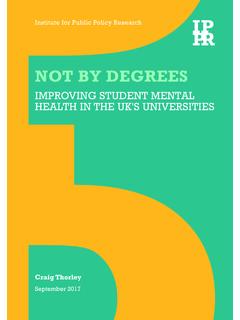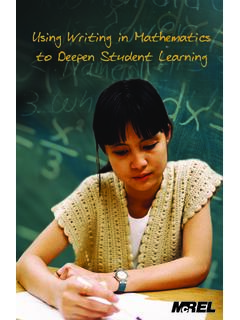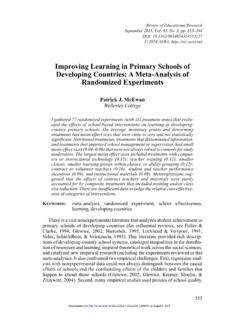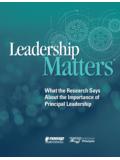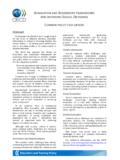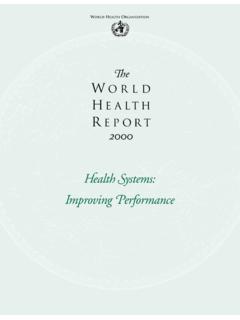Transcription of 4.8 Million College Students are Raising Children
1 IWPR #C424 November 2014 Million College Students are Raising Children Over a quarter (26 percent) of all undergraduate Students , or Million Students , are Raising dependent Women are disproportionately likely to be balancing College and parenthood, many without the support of a spouse or partner. Women make up 71 percent of all student parents, and roughly 2 Million Students , or 43 percent of the total student parent population, are single mothers. Single student fathers make up 11 percent of the student parent population (Figure 1).
2 2 Figure 1: Number of Student Parents at All Postsecondary Institutions by Sex and Marital Status Notes: Postsecondary institutions include degree-granting four-year and two-year institutions as well as for-profit, less than two year, and non-degree-granting institutions. An estimated 235,327 student parents attend non-degree granting institutions. Single is defined as Students who have never been married or are divorced, widowed or separated. Source: IWPR analysis of data from the Department of Education, National Center for Education Statistics.
3 2011 12 National Postsecondary Student Aid Study and the Integrated Postsecondary Aid Survey (IPEDS). Approximately Million student parents attend 2-year institutions, representing 30 percent of the entire community College student body. An additional Million student parents attend four-year institutions (public and private not-for-profit), representing 15 percent of the total four-year undergraduate student body, and Million student parents attend for-profit institutions, making up 51 percent of the student body at for profits.
4 The remaining 371,207 student parents attend other institutions or more than one Student MothersStudent FathersSingleMarriedAll student parents2,049,242 1,373,011 533,098 867,396 3,422,270 1,400,478 2 While as noted above, 26 percent of all Students are Raising Children , the share of women (32 percent) doing so is much higher than the share of men Raising Children (18 percent), and women of color are the most likely Students to be Raising Children while pursuing a postsecondary degree (Figure 2).
5 Nearly half of all black women in College have dependent Children (47 percent), followed by roughly two in five American Indian or Alaska Native and Native Hawaiian or Pacific Islander women (41 percent and 39 percent, respectively; Figure 2). While male Students are less likely, overall, than female Students to be parents, African American and Native American men in College have much higher rates of parenthood than men in other racial/ethnic groups. A quarter of black men in College are fathers, as are nearly a quarter (24 percent) of American Indian or Alaska native men (Figure 2).
6 Figure 2: Proportion of Undergraduate Students with Children by Race/Ethnicity and Gender Source: IWPR analysis of data from the Department of Education, National Center for Education Statistics. 2011-12 National Postsecondary Student Aid Study. Students with Children are especially unlikely to complete a certificate or degree within six years of enrollment, with only 33 percent attaining a degree or certificate in that They face significant time demands, with 56 percent of single parents devoting more than 30 hours per week to dependent care.
7 5 and often have significant financial Student parents are more likely than their counterparts without Children to have Sixty-one percent of all student parents have no money to contribute to College expenses ( they have an Expected Family Contribution of $0). Among single Students with Children , 88 percent have incomes at or below 200 percent of Students with Children also have much higher levels of debt after graduation than their nonparent counterparts (Figure 3). Student mothers average undergraduate debt one year after graduation 32%29%47%32%18%41%39%18%16%25%18%11%24%1 5%0%10%20%30%40%50%TotalWhiteBlackHispan icor LatinoAsianAmericanIndianor AlaskaNativeNativeHawaiianor PacificIslanderWomenMen3 is approximately $3,800 more than that of female Students with no Children , and nearly $5,000 more than that of male Students with no Children .
8 Figure 3: Average Undergraduate Debt One Year after Graduation by Gender and Parent Status Note: Average undergraduate debt is for Students with some undergraduate debt. Sample does not include Students with no undergraduate debt. Source: IWPR analysis of data from the Department of Education, National Center of Education Statistics. 2008 Baccalaureate and Beyond Survey data. Notes1 Barbara Gault, Lindsey Reichlin, and Stephanie Rom n. 2014. College Affordability for Low-Income Adults: Improving Returns on Investment for Families and Society.
9 Report, IWPR #C412. Washington, DC: Institute for Women s Policy Research. 2 Ibid. 3 Institute for Women s Policy Research. 2014. IWPR analysis of data from the Department of Education, National Center for Education Statistics. 2011 12 National Postsecondary Student Aid Study and the Integrated Postsecondary Aid Survey (IPEDS). 4 Institute for Women s Policy Research. 2014. IWPR analysis of data from the Department of Education, National Center for Education Statistics. 2003-04 Beginning Postsecondary Students Longitudinal Study, Second Follow-up (BPS:04/09).
10 5 Kevin Miller, Barbara Gault, and Abby Thorman. 2011. Improving Child Care Access to Promote Postsecondary Success among Low-Income Parents. Report, IWPR #C378. Washington, DC: Institute for Women s Policy Research. 6 Gault, Reichlin, and Rom n. College Affordability for Low-Income Adults. 7 Mark Huelsman and Jennifer Engle. 2013. Student Parents and Financial Aid. Working Paper, IWPR #C407. Washington, DC: Institute for Women s Policy Research. 8 Gault, Reichlin, and Rom n. College Affordability for Low-Income Adults.



